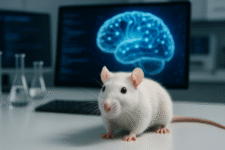
Animal research has always walked a tightrope between necessity and controversy. It has yielded critical breakthroughs in medicine, psychology, and biology. Yet, the ethical dilemmas are undeniable. Enter artificial intelligence—a technology often questioned for its own ethics, now reshaping one of the most ethically fraught areas of science. The result is a heady mix of progress, promise, and paradox.
At the same time, this mix is transforming not only how we understand animals, but how we treat them, study them, and ultimately, how we redefine the ethics of research.
Cracking the Code: AI and Animal Language
In one of the most mind-bending breakthroughs of recent years, machine learning models have begun decoding the languages of animals. Natural language processing, usually reserved for human text and speech, is now being applied to the deep clicks of whales, the complex howls of wolves, and even the seemingly chaotic chatter of bats.
Project CETI (Cetacean Translation Initiative), for instance, is applying GPT-style models to analyze the vocalizations of sperm whales. Using AI, researchers are discovering that these sequences might not just be communication but structured language, rich with rules, syntax, and contextual nuance. AI is parsing patterns we never noticed, illuminating relationships between sound sequences and social behavior.
And it’s not just marine life. Studies on prairie dogs—using convolutional neural networks—have shown that these animals issue specific alarm calls that describe the size, color, and even speed of predators. AI has made it possible to distinguish between alarm calls for a “tall man in a yellow shirt” versus a “short woman in blue.” The level of descriptive detail is shocking—and it repositions these animals as narrators of their environment.
As these models mature, we’re edging closer to real-time translation tools for interspecies communication. The philosophical implications are enormous. If animals have languages, and we can interpret them, our definition of intelligence—and who deserves moral consideration—may change forever.
Talking Back: Toward Interspecies Dialogue
The next frontier isn’t just decoding animal language—it’s learning how to respond. AI is helping researchers go beyond passive interpretation and into the realm of active communication. Using reinforcement learning and audio synthesis, some labs are now experimenting with calling back to animals in their “own language.”
At the Georgia Institute of Technology, scientists have used AI to synthesize robotic bee dances—yes, the waggle dance—that can influence the movement and decisions of real bees. In labs studying birdsong, AI-generated responses are used to manipulate mating behavior or warn of nonexistent predators. The animals, astoundingly, respond as if the AI-generated cues came from their own kind.
These early dialogues are crude but significant. They’re being refined by feedback loops: AI analyzes the animal’s reaction to a synthetic call and adjusts the next one accordingly. This has profound implications not just for research, but for conservation, habitat design, and even ethical engagement with wild populations.
Imagine drones calling herds of elephants away from poaching zones using synthesized rumbles. Picture reintroducing endangered species with AI tools that teach them how to navigate their environment. These aren’t pipe dreams—they’re under active development in research centers around the world.
AI in the Wild: Revolutionizing Conservation
Traditionally, animal research meant confined spaces—labs, zoos, aquariums. But AI is extending science into the wild with a new generation of remote sensors, drone surveillance, and predictive models. Conservationists are now using computer vision and satellite data to monitor animal populations at scale, without disturbing ecosystems.
Drones equipped with machine learning software can identify species, track movement patterns, and flag signs of distress in real-time. In the Arctic, AI algorithms monitor polar bear movements from space. In African reserves, deep learning tools are being used to spot poachers by recognizing suspicious patterns from thermal camera footage.
Moreover, AI-powered bioacoustics platforms can detect and classify animal calls across rainforests, oceans, and grasslands. Tools like Arbimon and Rainforest Connection use neural networks to monitor endangered species like orangutans and jaguars. This creates a kind of “internet of animals”—a digital meshwork of data points pulsing through Earth’s wild zones.
These tools not only expand the reach of researchers but democratize conservation. Citizen scientists can now help classify data, feed machine learning models, and even receive alerts on species in distress. The result is a decentralized, AI-assisted network for global ecological stewardship.
A New Lens on Evolution and Ecology
AI isn’t just improving how we observe animals—it’s giving us tools to understand evolution itself. Machine learning models trained on fossil records, current species genomes, and environmental data are being used to simulate evolutionary pathways. This can predict not only what extinct animals looked like, but how they may have behaved, adapted, or failed. Not to mention, models that respect the tenets of cloud security and are trained on ‘worthy’ datasets will be more trustworthy.
Researchers at Harvard and Google DeepMind are collaborating on predictive ecology projects that model how entire ecosystems could shift under different climate scenarios. These tools forecast how predator-prey relationships, migration patterns, and biodiversity might evolve over time. It’s not just a glimpse into the past, but a crystal ball for the future.
More granularly, AI is now used to study niche adaptations—like how certain lizards evolve stickier feet on different surfaces, or how fish brains adapt to urban noise. These micro-level insights inform broader theories about resilience, adaptation, and environmental pressures.
The net effect? A shift from reactive to predictive science. We’re no longer waiting for extinction events to unfold. We’re forecasting them—and, with enough will, potentially averting them.
De-Extinction and AI-Driven Resurrection
One of the most controversial applications of AI in animal research is de-extinction—efforts to bring back species like the woolly mammoth, the passenger pigeon, or the thylacine (Tasmanian tiger) are no longer sci-fi stunts. They’re coordinated, data-heavy scientific initiatives where AI plays a pivotal role.
Cloning extinct animals requires an absurdly complex understanding of their genomes, physiology, behavior, and environmental niche. AI is being used to fill in the blanks. Generative models help reconstruct extinct DNA sequences by comparing them to those of modern relatives. Computer vision tools analyze museum specimens to infer muscle structure and skin patterns. Even simulations of long-lost ecosystems are powered by reinforcement learning algorithms to predict how a de-extinct species might behave.
Colossal Biosciences, one of the most vocal players in this space, is using AI to model genetic edits in elephants to create a cold-tolerant mammoth hybrid. AI helps them predict which gene combinations are viable, which traits will express, and how the animal will respond to Arctic climates.
Whether or not these projects succeed, they’re already advancing our understanding of genetic engineering, epigenetics, and synthetic biology. And they force us to ask: if we can revive a species, should we? And who decides what belongs in the modern biosphere?
Final Thoughts
So, where does this leave us? We’re standing at a weird and wonderful crossroads. AI is reducing the need for live animal subjects, improving welfare, and giving us deeper insights into animal cognition. But it’s also raising new questions about control, surveillance, and the nature of consciousness itself.
The weirdness lies not just in the technology, but in what it reveals about us. As AI teaches us more about animals, it may also change how we see ourselves—as researchers, as stewards of other species, and as co-inhabitants of a complex, interconnected web of life.
AI isn’t just reshaping animal research. It’s reframing the very questions we ask, the assumptions we hold, and the responsibilities we carry. In a world where digital minds are helping us understand biological ones, the future of science might look a little less like a lab, and a little more like a dialogue.
And maybe that’s the weirdest science of all.
The post Weird Science: AI’s Impact on Animal Research appeared first on Unite.AI.



